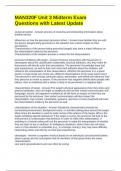MAN320F Unit 3 Midterm Exam
Questions with Latest Update
social perception - Answer-process of receiving and interpreting information about
another person
influences on how the perceiver perceives others - Answer-How familiar they are with
the person (target) being perceived or the situation has a direct impact on their
perceptions.
Characteristics of the person being perceived (target) also have a major influence on
the interpretation made by the perceiver.
Characteristics of the situation provide a context for the interpretations
perceiver familiarity with target - Answer-Previous encounters with that person or
stereotypes about the classification (nationality, physical attributes, etc) they make for
that person will directly color their perceptions. The perceiver's knowledge base and
past experiences, as well as their own mood and attitudes about the situation, will
influence the interpretation of their observations. Whether the perceiver is in a good
mood or a bad mood can create very different interpretations of the exact same event.
The perceiver's self-concept, personal values, personality, and beliefs will influence how
they perceive an event or person. If the perceiver has negative beliefs about people with
tattoos, then an individual with a tattoo is likely to be perceived in a negative light.
characteristics of target - Answer-The target's physical appearance (how they dress and
physical attributes, such as height or weight) as well as their verbal communication skill
(language, accent, and apparent confidence) all will have an impact on how they are
perceived by the perceiver. Non-verbal communication will also impact the
interpretation. Eye-contact, handshake, gestures, and tone of voice (loud/soft) will color
the interpretations made by the perceiver as well.
characteristics of the situation - Answer-Situational characteristics include the
surrounding environment, background noise, or activities taking place around the target.
Many times the situation is used to make sense of the actions of the target. Why is the
target exhibiting specific behaviors? If the target is crying, the perceiver will look to the
environment to contextualize that behavior in order to make their interpretation. A
wedding or a funeral setting will cue the perceiver to make the interpretation of whether
they are tears of joy or sadness. In ambiguous situations, where there are not many
cues or if the situation is unfamiliar (e.g., in a foreign country), they may have difficulty
interpreting action and will rely on their past experiences.
stereotype - Answer-a cognitive shortcut based on an individual's preconceived beliefs
about a group and the assumption that all members of that group share the same
characteristics.
very quick generalizations and can often be wrong
, can lead to poor decisions and discrimination when used too broadly
ignore individual differences by grouping people together based only on one or two
characteristics about which the perceiver has a specific belief
not always negative and can, sometimes, be quite useful, such as when an individual
uses them to make a quick assessment of whether or not a situation looks safe, or
whether a person represents a threat to them
stereotyping in a 4 step process - Answer-- Step 1: Categorizing people into groups
based on some distinguishing feature such as skin color, hair color, height, weight, or
some other feature.
- Step 2: Inferring that all people in a category possess similar traits or characteristics
(i.e., all tall people are arrogant).
- Step 3: Formation of expectations of people assigned to that group and the
interpretation of their behavior accordingly (e.g., Bill is tall, and he didn't say hello this
morning. He didn't say hello because tall people are arrogant).
- Step 4: Maintenance and reinforcement of the stereotype. This is done by ignoring
stimuli or information that isn't consistent with the stereotype and overemphasizing
stimuli or information that can be interpreted as supporting the stereotype (e.g., Jim is
tall and he is very friendly. Jim is pretty friendly, for a tall person).
halo/horns effect - Answer-occurs when a perceiver allows a characteristic or general
feeling about a person or object to positively (halo) or negatively (horns) influence other
assessments of the person or object (i.e., rating the performance of graduates of your
alma mater more positively than they really earned, just because of the school from
which they graduated). In the work place, this is potentially found in performance
ratings, hiring and promotion decisions, and work assignments. This obviously brings up
fairness issues and negatively impacts organizational performance by overlooking or
bypassing qualified people in favor of truly less qualified people.
selective perception - Answer-the tendency to define problems from one's own point of
view
- Impact occurs in the attention stage of the perceptual process
- You pick what you think is the problem based on your area of work
- Kind of like a bias
refers to the tendency to perceive only those aspects of the situation or person that are
consistent with the perceiver's point of view, needs, values, or beliefs. When a person
only attends to these aspects they will typically miss or misinterpret other aspects that
could be critically important and could change the decision or course of action taken.
One example is from Sherlock Holmes in "Silver Blaze" by Sir Arthur Conan Doyle
where reference is made to "the dog that did not bark," which was the key to solving the
mystery. Here, the fact that the dog did not bark during the incident indicated that the
dog knew the person involved. In selective perception, one would be more likely to look
for clues that did occur rather than looking at those clues that did not.
projection - Answer-assigns personal attributes to other individuals
- Likely to occur in the interpretation stage of perception




